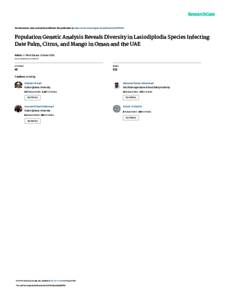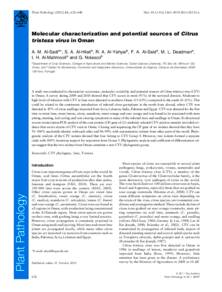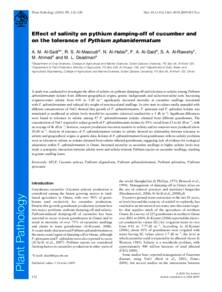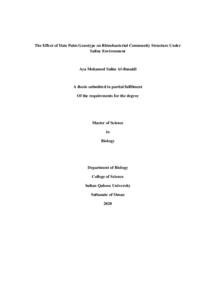Document
Population genetic analysis reveals diversity in Lasiodiplodia species infecting date palm, citrus, and mango in Oman and the UAE.
Identifier
DOI: 10.1094/PDIS-03-13-0245-RE
Contributors
Al-Wehaibi, A. N., Author
Al-Shariqi, R. M., Author
Al-Hammadi, M. S., Author
Al-Hosni, I. A., Author
Al-Mahmooli, I. H., Author
Al-Ghaithiyah, A. G., Author
Publisher
Elsevier B. V.
Gregorian
2013
Language
English
Subject
English abstract
Lasiodiplodia is a common pathogen causing dieback, gummosis, or root necrosis on the three most important fruit crops in Oman and the United Arab Emirates (UAE): date palm (Phoenix dactylifera), Citrus spp., and mango (Mangifera indica). A study was conducted to examine diversity in 64 Lasiodiplodia isolates infecting date palm (24), Citrus (11), and mango (29) in Oman and the UAE. Identification based on sequences of the internal transcribed spacer (ITS) rDNA and EF1α gene showed that date palm isolates belonged to L. hormozganensis (75% of isolates) and L. theobromae (25%); Citrus isolates belonged to L. hormozganensis (45%), L. theobromae (45%), and L. iraniensis (10%); and mango isolates belonged to L. theobromae (59%), L. iraniensis (34%), and L. hormozganensis (7%). Amplified fragment length polymorphism (AFLP) fingerprinting of the 64 isolates using four primer pair combinations produced 64 genotypes and 972 polymorphic alleles. Cluster analysis separated the isolates into four clusters representing the three species. A higher level of genetic diversity was observed in L. iraniensis (0.3105) compared to L. hormozganensis (0.2503) and L. theobromae (0.2331) in Oman. Analysis of molecular variance (AMOVA) indicated the existence of low levels of genetic differentiation among date palm populations of L. hormozganensis obtained from Oman and the UAE (FST = 0.025) and among populations of L. hormozganensis (0.0485) and L. theobromae (0.0703) from date palm, Citrus, and mango. These findings imply a high rate of movement of L. hormozganensis and L. theobromae isolates among date palm, Citrus, and mango and between the two countries. Findings from the pathogenicity test supported the AMOVA analysis and suggested a lack of host specialization in L. hormozganensis, L. iraniensis, and L. theobromae on date palm, acid lime, and mango. Although this is the first record of L. hormozganensis and L. iraniensis in Oman, the relatively moderate level of genetic diversity in the two species compared to L. theobromae suggests that the two species have been in Oman for a long time but misidentified by morphology and ITS rDNA sequences as L. theobromae. This study is also the first record of date palm and acid lime as natural hosts for L. hormozganensis and the first record of L. hormozganensis in the UAE. The diversity in Lasiodiplodia species affecting date palm, Citrus, and mango in Oman and the UAE should be taken into consideration when planning future management programs for diseases caused by these pathogens.
Member of
ISSN
0191-2917
Resource URL
Category
Journal articles




